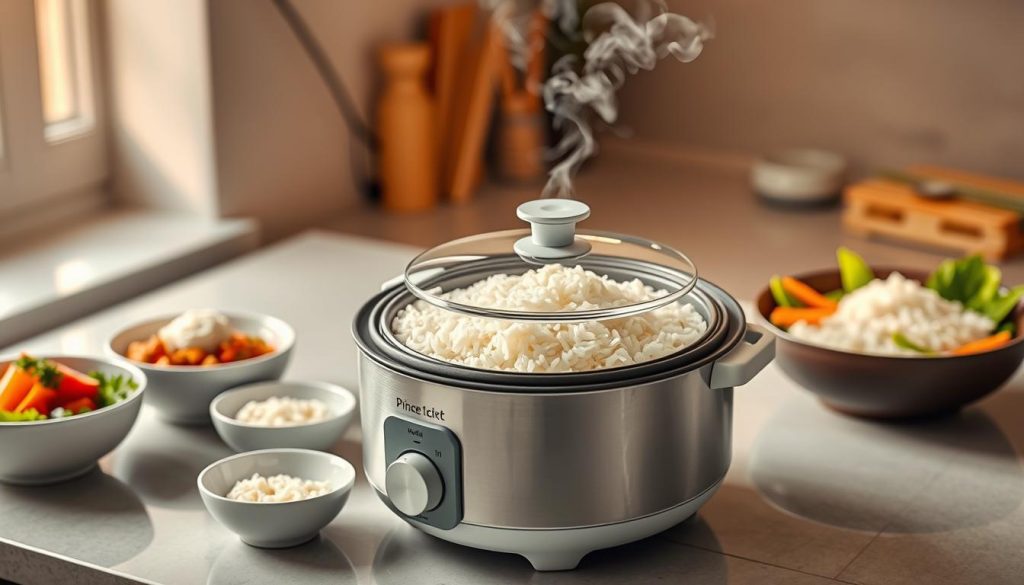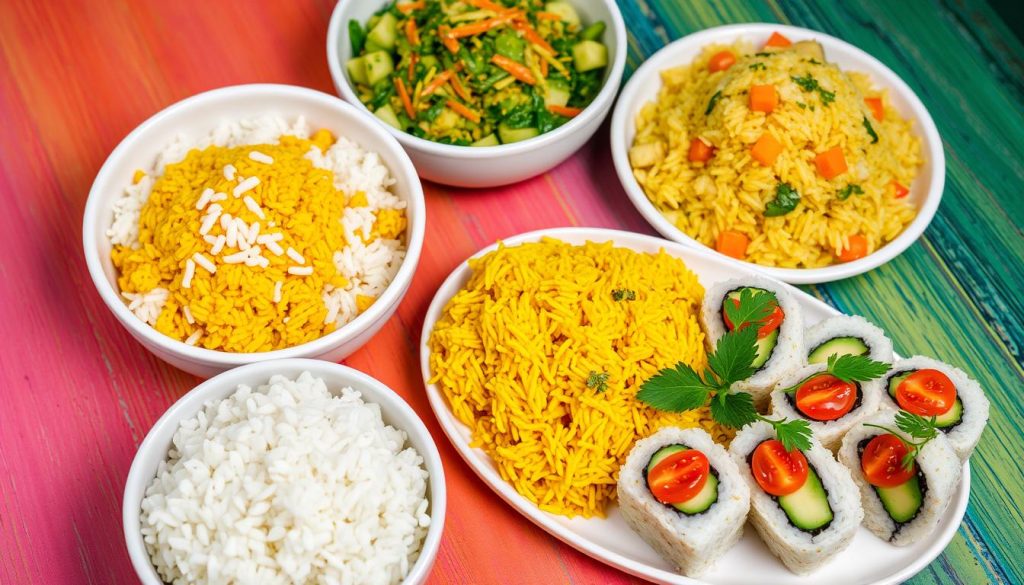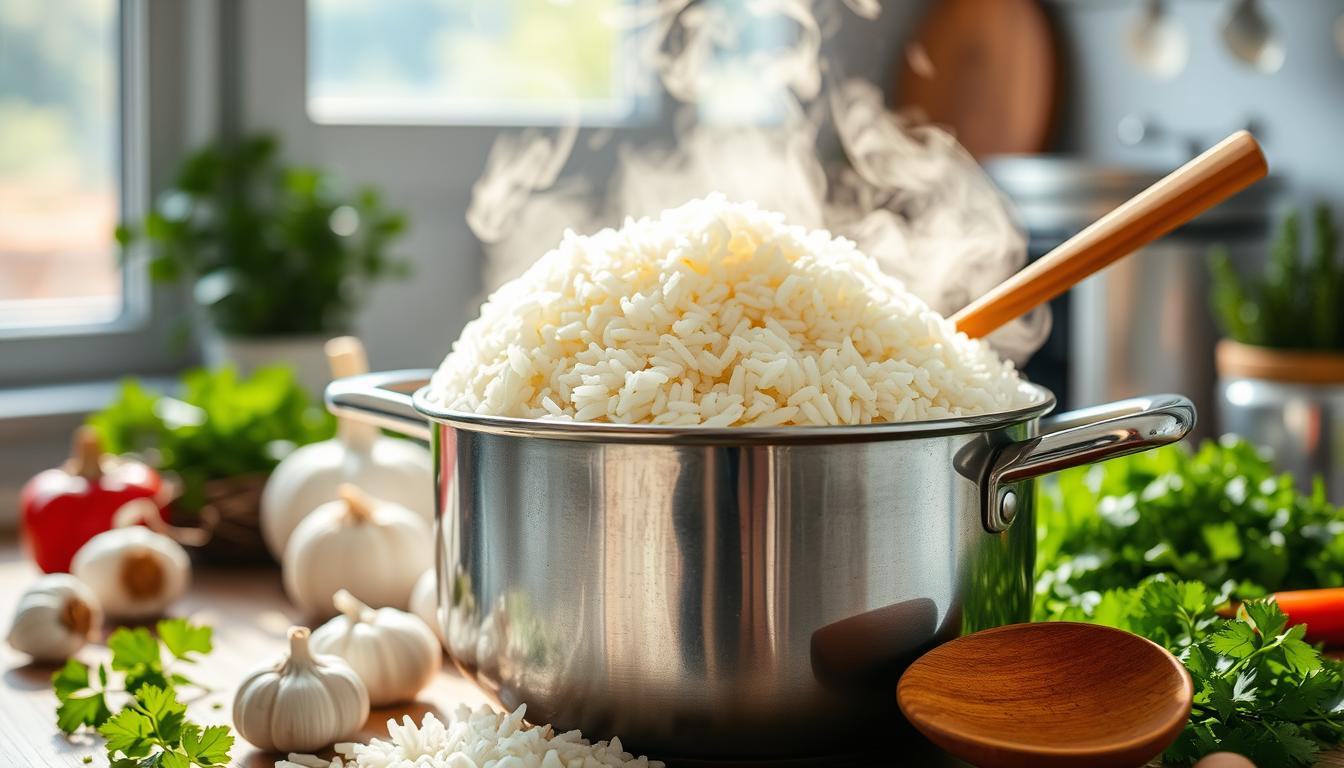Cooking rice perfectly can seem hard, but with the right tips, you’ll get it right in no time. This guide covers the top ways to cook rice, from stovetop to rice cooker. We’ll also dive into cooking basmati and jasmine rice. You’ll learn essential techniques and how to fix common problems, making you a rice cooking expert.
Key Takeaways
- Discover the best methods for cooking rice on the stovetop and using a rice cooker
- Learn the essential techniques for achieving perfect, fluffy rice texture
- Explore tips and tricks for preparing specialty rice varieties like basmati and jasmine
- Understand the importance of adjusting cooking times for healthier brown rice
- Access foolproof rice recipes, including classic pilaf and coconut rice
- Troubleshoot common rice cooking issues to ensure consistent, delicious results
- Enhance your rice cooking skills and elevate your meals with these expert-approved techniques
Introduction to Cooking Perfect Rice
Rice is a staple food enjoyed by people all over the world. But, mastering the art of cooking it to perfection can be a challenge. It’s important to understand the importance of mastering rice cooking and explore the diverse varieties of rice available.
Why Mastering Rice Cooking is Important
Cooking rice correctly is essential for several reasons. It ensures you get the desired texture, whether it’s light and fluffy or rich and creamy. Properly cooked rice can enhance the flavors of the dishes it accompanies, making the entire meal more enjoyable.
Additionally, mastering rice cooking can help you maximize the nutritional value of this versatile grain. Different cooking methods can impact the retention of essential nutrients.
Overview of Different Rice Varieties
The world of rice is vast and diverse, with a wide range of varieties to explore. From the fragrant basmati and jasmine rice to the hearty brown rice and the versatile long-grain and short-grain options, each type of rice has its own unique characteristics and optimal cooking methods.
Understanding the differences between these rice varieties is key to achieving the perfect texture and flavor in your dishes.
| Rice Variety | Characteristics | Nutritional Profile |
|---|---|---|
| Basmati Rice | Long, slender grains with a distinctive aroma and flavor | Low in calories, high in fiber, and a good source of protein |
| Jasmine Rice | Fragrant, long-grain rice with a slightly sticky texture | Low in fat, high in carbohydrates, and a good source of B vitamins |
| Brown Rice | Whole-grain rice with a nutty flavor and chewy texture | High in fiber, magnesium, and other essential nutrients |
By understanding the unique characteristics and nutritional profiles of different rice varieties, you can make informed choices. This enhances the overall quality and enjoyment of your rice-based dishes.
Essential Techniques for Flawless Rice
Cooking rice perfectly is more than just a recipe. It’s about mastering key techniques. These steps ensure your rice is fluffy, tender, and not sticky.
Rinsing and Measuring: The Keys to Success
Rinsing rice is a crucial step. It removes excess starch, preventing clumps and bad texture. Just rinse the rice in a fine-mesh strainer under cool water until it’s clear.
After rinsing, measure the rice and water accurately. A good ratio is 1 cup of rice to 1.5 cups of water. This ensures even cooking and the right liquid absorption.
Temperature Control: The Secret to Flawless Texture
Temperature is key for perfect rice texture. Boil the water fast, then lower the heat to a simmer. Keep the temperature steady to avoid mushy rice.
By mastering these techniques, you’ll make restaurant-quality rice. Remember, paying attention and being patient are crucial for success.
| Rice Cooking Technique | Importance |
|---|---|
| Rinsing the Rice | Removes excess starch, prevents clumping and stickiness |
| Measuring the Rice-to-Water Ratio | Ensures even cooking and optimal moisture absorption |
| Maintaining Consistent Temperature | Prevents overcooking or undercooking, results in a perfect texture |
“Attention to detail and a little patience can make all the difference in the final outcome of your rice.”
Best Way to Cook Rice on the Stovetop
The stovetop is a classic and versatile method for cooking stovetop rice. Whether you like fluffy, tender grains or a chewy bite, learning to cook stovetop rice can boost your cooking skills. It will also impress your dinner guests.
Stovetop Rice Cooking Methods
There are two main ways to cook stovetop rice: the absorption method and the boiling method. The absorption method simmers the rice in liquid until it’s fully absorbed. This makes the rice light and fluffy. The boiling method cooks the rice in boiling water, like pasta.
Tips for Perfect Stovetop Rice Texture
To get the perfect stovetop rice texture, follow these tips:
- Use the right rice-to-water ratio: A 1:2 ratio is a good starting point, depending on the rice type.
- Let the rice rest: After cooking, let it sit for 5-10 minutes with the lid off. This helps moisture evaporate.
- Fluff the rice with a fork: Gently fluffing the rice separates the grains and prevents sticking.
- Experiment with cooking times: Adjust the time based on rice type and desired texture. Longer times make rice softer and stickier.
With these stovetop rice tips and techniques, you’ll master the perfect stovetop rice every time.
Mastering the Rice Cooker
The rice cooker is a game-changer for those who like a hands-off approach to cooking rice. It makes cooking grains easy with little effort. We’ll look at how it can change your rice cooking experience.
Advantages of Using a Rice Cooker
The rice cooker has many benefits. It’s loved by home cooks and chefs. Let’s explore these advantages:
- Consistent Results – Rice cookers cook rice perfectly every time. You don’t have to worry about it being under or overcooked.
- Hands-off Convenience – Just set it and forget it. You can focus on other meal prep without watching the stovetop.
- Versatility – Modern rice cookers can cook many grains. This includes white rice, brown rice, quinoa, and oats, opening up new recipes.
- Automatic Warming – After cooking, most rice cookers warm the rice. This keeps it at the right temperature until you’re ready to eat.
Whether you’re an experienced cook or just starting, a good rice cooker makes cooking rice easy. It gives you rice cooker usage, rice cooker benefits, and rice cooker cooking with ease.

Achieving Fluffy Basmati Rice Perfection
Cooking basmati rice is an art that makes any meal better. It’s known for its light, fluffy texture and delicate flavor. By using a few key techniques, you can make sure each grain of basmati rice stays separate and light. This creates a wonderful dining experience.
First, rinse the basmati rice well before cooking. This removes extra starch, so the grains don’t stick together. After rinsing, let the rice soak for 30 minutes to an hour. This step is key for getting that perfect basmati rice texture.
- Use a 1:1.5 rice-to-water ratio for the best results. This ratio helps the grains cook evenly and stay light and fluffy.
- Boil the water, then lower the heat to low. Cover the pot and let the basmati rice simmer for 15-20 minutes. Don’t lift the lid during this time.
- After the time is up, take the pot off the heat and let it sit, covered, for 10-15 minutes more. This lets the rice finish cooking and absorb excess moisture.
By following these easy basmati rice cooking tips, you’ll get perfectly cooked, light and fluffy grains every time. Try different techniques to find what you like best. Enjoy the delicious flavors of basmati rice in your favorite dishes.
“The secret to cooking basmati rice is all in the preparation and gentle cooking method. With a little care and attention, you can achieve restaurant-quality results at home.”
Secrets to Cooking Jasmine Rice Like a Pro
Jasmine rice is known for its fragrant and versatile nature. It adds elegance to any meal. Learning to cook jasmine rice like a pro can change your kitchen game. We’ll share the secrets to get the perfect texture and aroma every time.
Preparing Jasmine Rice Properly
The secret to great jasmine rice is in how you prepare it. Here are the essential steps:
- Rinse the rice: Start by rinsing the jasmine rice under cool water. This removes excess starch for a better texture.
- Soak the rice: Soak the rinsed rice in water for 30 minutes to an hour. This makes the grains fluffier and more tender.
- Use the right rice-to-water ratio: For jasmine rice cooking, use 1:1.5 water to rice. So, for every cup of rice, use 1.5 cups of water.
- Cook at a gentle simmer: Bring the rice and water to a boil, then lower the heat. Cover and cook for 15-20 minutes.
- Fluff and serve: After cooking, let the pot sit, covered, for 5-10 minutes. Then, fluff the rice with a fork and serve.
By following these jasmine rice preparation steps, you’ll get perfect jasmine rice every time.
“The aroma of freshly cooked jasmine rice is like a warm embrace, inviting you to savor its delicate flavors and fluffy texture.”
Cooking Brown Rice the Healthy Way
Brown rice is a whole-grain that’s packed with health benefits. It keeps the nutrient-rich bran and germ layers, unlike white rice. Cooking brown rice right is key to getting the best taste and nutrition.
Adjusting Cooking Times for Brown Rice
Getting brown rice just right is all about the cooking time. It takes longer than white rice because of its tough bran layer. Here’s how to cook it perfectly:
- Start with a 15-20 minute longer cooking time than white rice. This makes it tender and absorbs the liquid well.
- Use a 1 cup brown rice to 2 cups water or broth ratio. This keeps it from getting mushy.
- Simmer it gently on the stovetop. Avoid boiling too fast to prevent overcooking the outside before the inside is done.
- Let it rest for 5-10 minutes before fluffing with a fork. This step is crucial for the right texture.
By tweaking the cooking times and methods, you can bring out the best in brown rice. Enjoy its rich, nutty taste and health benefits.
| Rice Type | Cooking Time | Liquid to Rice Ratio |
|---|---|---|
| White Rice | 12-15 minutes | 1 cup rice : 1.5 cups liquid |
| Brown Rice | 25-30 minutes | 1 cup rice : 2 cups liquid |
Follow these tips and adjust cooking times to get brown rice that’s both healthy and tasty.
“Adding brown rice to your meals can greatly improve your health and well-being.”
Best Way to Cook Rice: Foolproof Recipes
Learning to cook rice opens up a world of flavors. You can make everything from simple rice pilaf to creamy coconut rice. These recipes are easy to follow and will make your rice dishes stand out.
Classic Rice Pilaf Recipe
Rice pilaf is a beloved dish that’s easy to make. It’s a mix of spices, veggies, and fluffy rice. It’s great as a side dish for many meals. The secret to a good pilaf is sautéing the aromatics right and cooking the rice just right.
- In a large skillet, sauté onions, garlic, and your favorite veggies until they’re soft and smell good.
- Add white rice and cook until it’s lightly browned, stirring often.
- Pour in chicken or veg broth and let it boil.
- Lower the heat, cover, and simmer for 15-20 minutes. The rice should be tender and the liquid gone.
- Use a fork to fluff the rice. Serve it hot, topped with fresh herbs and parmesan cheese.
Coconut Rice with Tropical Flavors
This coconut rice recipe brings the tropics to your table. It’s made with basmati rice, coconut milk, lime, and cilantro. It’s creamy, flavorful, and aromatic.
- Rinse the basmati rice well to get rid of extra starch.
- In a saucepan, mix the rice, coconut milk, water, and a bit of salt.
- Let it boil, then lower the heat, cover, and simmer for 15-20 minutes. The rice should be tender and the liquid gone.
- Fluff the rice with a fork and add chopped cilantro and lime juice.
- Serve the coconut rice warm. Add toasted coconut flakes or mango slices for extra tropical flavor.
These two recipes, rice pilaf and coconut rice, are great ways to cook rice. They’re easy to make and perfect for many meals. Try them out and get creative in the kitchen.

Troubleshooting Common Rice Cooking Issues
Cooking rice can be tricky, even for experienced chefs. You might face problems like mushy, sticky, or undercooked rice. But don’t worry, there are ways to fix these issues and get the perfect rice every time.
Mushy or sticky rice is a common problem. It usually happens when you use too much water or cook it too long. To avoid this, measure the rice and water carefully. Use the right ratio for your type of rice. Also, watch the cooking time and stop when the rice is just tender.
Undercooked rice means you might need to adjust the cooking time or the water ratio. Try adding a bit more water and simmer for a few more minutes. This should help the rice cook fully. On the other hand, if your rice is too dry, you might have used too little water or cooked it too long. Next time, add more water or cook it for less time to get the fluffy texture you want.

